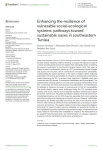Charieg H., Dhraief M.Z., Gharbi I., Ben Saad A. (2025). Enhancing the resilience of vulnerable social-ecological systems: pathways toward sustainable oases in southeastern Tunisia. Frontiers in Sustainable Food Systems, 01/01/2025, vol. 9, p. 1623641.
https://doi.org/10.3389/fsufs.2025.1623641
https://doi.org/10.3389/fsufs.2025.1623641
| Titre : | Enhancing the resilience of vulnerable social-ecological systems: pathways toward sustainable oases in southeastern Tunisia (2025) |
| Auteurs : | H. Charieg ; M.Z. Dhraief ; I. Gharbi ; A. Ben Saad |
| Type de document : | Article |
| Dans : | Frontiers in Sustainable Food Systems (vol. 9, 2025) |
| Article en page(s) : | p. 1623641 |
| Langues : | Anglais |
| Langues du résumé : | Anglais |
| Catégories : |
Catégories principales 07 - ENVIRONNEMENT ; 7.4 - Ressources Naturelles : Paysage, Biodiversité, Patrimoine naturelThésaurus IAMM ORGANISATION SOCIOECONOMIQUE ; OASIS ; GESTION DES RESSOURCES NATURELLES ; VULNERABILITE ; DURABILITE ; TUNISIE |
| Résumé : | Oases have long been a source of life for farming communities in regions characterized by water scarcity. Adopting "resilience thinking" to analyze the capacity of oases to continue providing goods and services despite their vulnerability means considering the various components in one Social-Ecological System (SES). The oases of Gab & egrave;s, located in southeastern Tunisia, as a SES, have witnessed several changes and shocks over the years, which contributed to increasing their vulnerability. Understanding the system dynamics of the oases of Gab & egrave;s enables analyzing stakeholder connectivity and variables of influence to develop policy orientations toward preserving the SES. To achieve these objectives, a detailed survey was conducted with 240 farmers, 10 institutional stakeholders and 9 associations. The questionnaires included questions on social and ecological characteristics of the SES, connectivity and interactivity between key stakeholders, and identification of variables of influence and ways of improvement for the SES sustainability. The results identify several major challenges facing the SES, including water scarcity, land tenure, and the lack of adequate regulation and financial support for farmers. Furthermore, the power and influence analysis reveal that farmers have considerable influence over the SES's trajectory, especially their role in sustaining agricultural activity and maintaining ecosystem services. However, stakeholder perceptions are divided especially concerning the role of the industrial sector, which is often viewed as a threat to SES sustainability due to its impact on water resources and land use. The analysis enabled constructing a causal loop diagram discussing the impact of water resource availability on agricultural activities. It also highlighted key policy implications by presenting ways of improvement on issues related to improving water availability for irrigation, the development of an adapted financing framework, the implementation of adequate regulation measures, and the clarification of land tenure arrangements. |
| Cote : | En ligne |
| URL / DOI : | https://doi.org/10.3389/fsufs.2025.1623641 |







